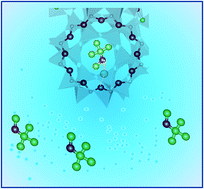Influence of water on the retention of methyl tertiary-butyl ether by high silica ZSM-5 and Y zeolites: a multidisciplinary study on the adsorption from liquid and gas phase†
Abstract
Ambient temperature adsorption isotherms have been determined for methyl tert-butyl ether (MTBE) in aqueous solutions on high silica ZSM-5 and Y zeolites which differ from each other in framework topology and pore window apertures. The comparison of their adsorption properties was performed to evaluate the importance of the competitive interference of water with pore size. The adsorption Henry's constants for MTBE decrease with an increase in the zeolite pore size, indicating that confinement of the adsorbate in the zeolite pores is a driving force for adsorption. On the contrary, the saturation capacity increases with an increase in the adsorbent pore size (i.e. about 95 and 250 mg g−1 for ZSM-5 and Y, respectively). These data were confirmed from Rietveld refinement, that clearly revealed the incorporation of about 8 and 32 MTBE molecules per ZSM-5 and Y unit cell respectively. X-ray diffraction and IR spectroscopy indicate that significant clustering of the guest molecules (i.e. water and MTBE) occurs in the two investigated zeolites during adsorption from both the liquid and gas phase. The clusters originate from hydrogen bonding between MTBE and water molecules and their interaction with zeolite lead to framework flexibility for both zeolites. However, the framework deformation in Y is more evident than in ZSM-5 and occurs with a change of the real symmetry. These findings could have an impact on the adsorption, separation and catalytic use of zeolites for oxygenate compounds.


 Please wait while we load your content...
Please wait while we load your content...